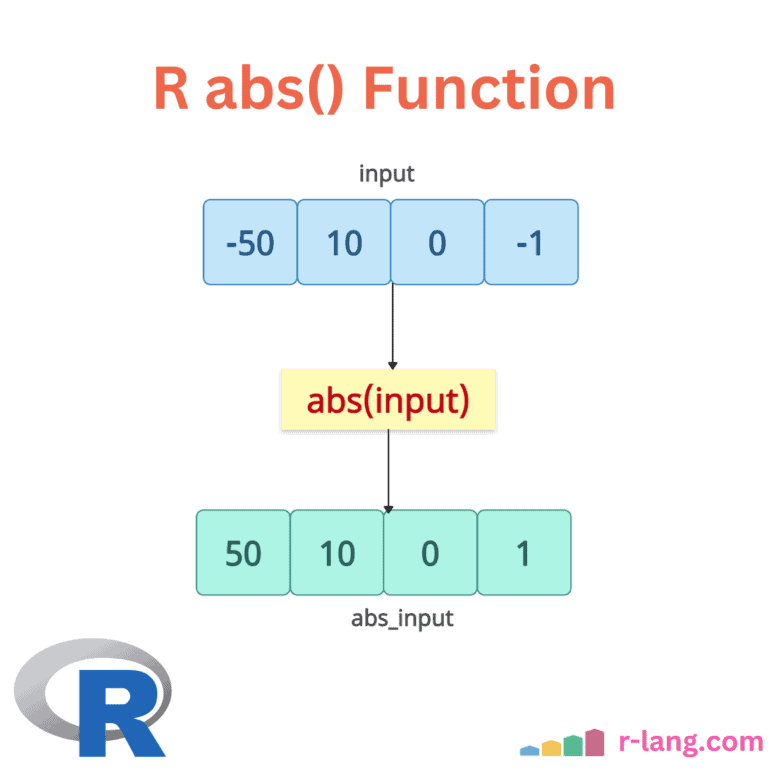The abs() function calculates the absolute value of a numeric input, returning a non-negative (only positive) value by removing any sign.
Usage of absolute value is high in fields like mathematical computations (mean absolute errors), statistical analysis, and data cleaning in ML tasks.
Syntax
abs(input)
Parameters
| Argument | Description |
| input | It defines the input object.
It can be anything from a single numeric value (integer, double, or complex), a vector, a matrix, or an array to a data frame or its columns. |
Single numeric value
If the input is negative, this method returns a positive number. If the input is already a positive number, it will return the same value as the input.
answer1 <- abs(-21)
answer2 <- abs(19)
answer3 <- abs(-46)
answer1
answer2
answer3
# Output:
# [1] 21
# [1] 19
# [1] 46Complex numbers
For complex numbers, this method returns the modulus (magnitude).
complex_num <- 3 + 4i
abs(complex_num)
# Output: [1] 5
Numeric vector
It performs element-wise operations on vectors, matrices, or arrays.
vec <- c(11, -21, 19)
abs_vec <- abs(vec)
abs_vec
# [1] 11 21 19The above output shows that the abs() method preserves the input vector structure. Zero remains unchanged.
Handling missing values
In real-time data, you may encounter a vector or any data structure that has NA values. If this method encounters an NA value, it will return as is.
vec_with_na <- c(-1, NA, 0)
abs_with_na <- abs(vec_with_na)
abs_with_na
# Output: [1] 1 NA 0Matrix
What if the input is a matrix? Well, it will apply this method individually to each element and return the positive value for each input value while preserving the input structure.
vec <- c(1, 2, -3, 4, 5, -6, -7, -8, -9)
mtrx <- matrix(vec, nrow = 3, ncol = 3, byrow = TRUE)
mtrx
cat("Absolute value of matrix", "\n")
abs_mtrx <- abs(mtrx)
abs_mtrxData frame
df <- data.frame(
col1 = c(1, -2, -3),
col2 = c(4, -5, 6),
col3 = c(-7, 8, -9)
)
df
print("After calculating the absolute value of data frame")
df_abs <- abs(df)
df_abs
Output
Specific data frame column
Sometimes, you need to find the absolute value of a specific column and not the whole data frame.
df <- data.frame(
col1 = c(1, -2, -3),
col2 = c(4, -5, 6),
col3 = c(-7, 8, -9)
)
df
print("After calculating the absolute value of data frame")
df_col_abs <- df
df_col_abs$col3 <- abs(df_col_abs$col3)
df_col_absAbsolute difference between two values
diff <- 19 - 21
diff_abs <- abs(diff)
diff_absOutput
[1] 2
Errors
Case 1
If you encounter the error Error in abs(“Rlang”) : non-numeric argument to mathematical function, that means you passed a character vector or string to the abs() method.
abs("Rlang")
# Output: Error in abs("Rlang") : non-numeric argument to mathematical functionDon’t pass the character vector to a numeric function. This will prevent the above error from occurring.
Case 2
Error in Math.factor(x) : ‘abs’ not meaningful for factors typically occurs when you are trying to apply a mathematical function (like abs()) to a factor variable.
Factor variables are categorical variables that take on a limited number of different values; they aren’t numerical and, therefore, can’t be used in most mathematical operations.
x <- factor(c("1", "2", "3"))
abs(x)
Error in Math.factor(x) : ‘abs’ not meaningful for factors
To fix this error, you must “ensure that the variable you are passing to abs() (or any other mathematical function) is numerical”. If the variable is stored as a factor but represents numbers (e.g., “1”, “2”, “3”), you can convert it to numeric with the as.numeric() function.
x <- factor(c("-1", "2", "-3"))
abs(as.numeric(as.character(x)))
# Output: [1] 1 2 3
Real-World Application: Mean Absolute Error (MAE)
To calculate Mean Absolute Error, we need to calculate the average of the absolute differences between actual and predicted values.
actual <- c(10, 20, 30, 40)
predicted <- c(12, 18, 33, 37)
mae <- mean(abs(actual - predicted))
mae
# Output: 2.5
That’s all!

Krunal Lathiya is a seasoned Computer Science expert with over eight years in the tech industry. He boasts deep knowledge in Data Science and Machine Learning. Versed in Python, JavaScript, PHP, R, and Golang. Skilled in frameworks like Angular and React and platforms such as Node.js. His expertise spans both front-end and back-end development. His proficiency in the Python language stands as a testament to his versatility and commitment to the craft.









